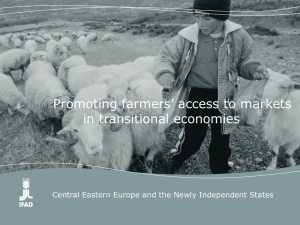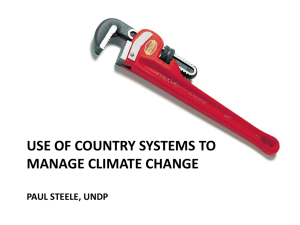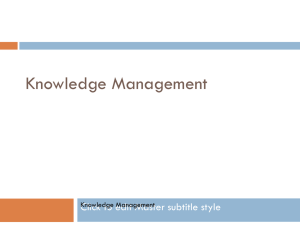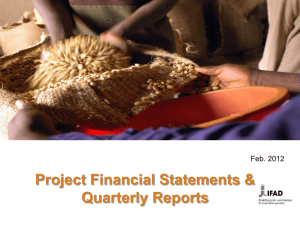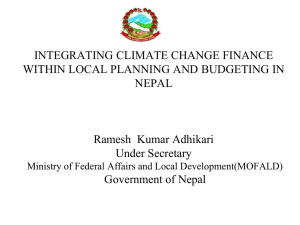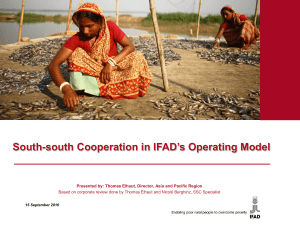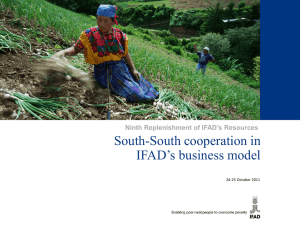Session Loan Administration
advertisement
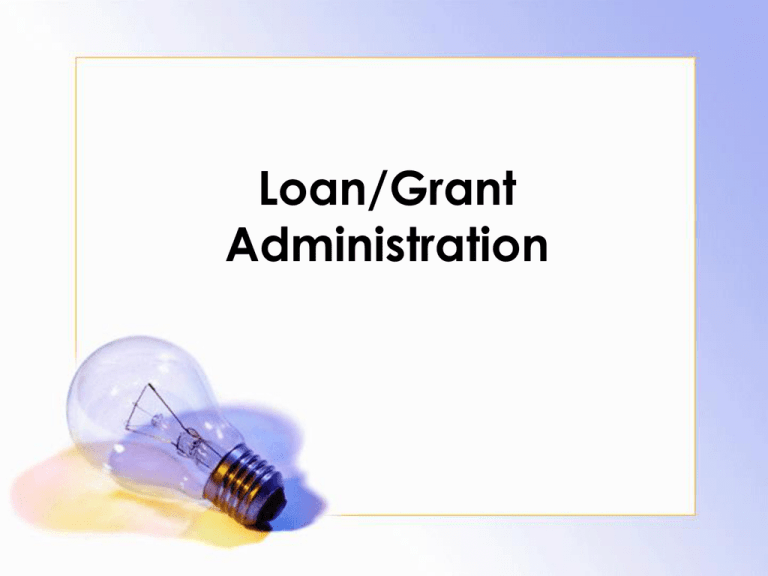
Loan/Grant Administration Types of Financing • Highly concessional • Hardened terms • Intermediate terms • Ordinary terms Description of lending terms • Highly concessional – no interest, service charge of 0.75%, repayment in 40 years including 10 years grace period • Hardened terms – no interest, service charge 0.75%, repayment in 20 years including 10 years grace period • Intermediate terms – interest @ 0.5% of IFAD Reference rate, maturity period 20 years including 5 years grace period • Ordinary terms – interest on par with IFAD Reference rate, maturity period 15-18 years including 3 years grace period Basic documents • Financing Agreement • Letter to the Borrower • Loan Disbursement Handbook • AWPB • Procurement Plan Standard Procedures • Replenishment to Special Account/Designated Account • Reimbursement • Direct Payment • Special Commitment Special Account/Designated Account • Provides a mechanism, somewhat like an imprest account • Borrower should have sufficient control and financial systems • Should be in a currency and bank acceptable to IFAD Special Account/Designated Account • Initial deposit will be determined by the Borrower • Administered by CAA&A • Audit of Special Account done by the office of C&AG • Ceiling of Authorised Allocation Replenishment • Should be in USD • Atleast or equal to 20% of the advance Reimbursement • Outside Designated Account • For Government pre-financed expenditure • Could be in any currency requested by the borrower • Will not flow to Designated Account • Should not be later than 3 months Direct Payment • IFAD directly pays third party • Project instructs IFAD to pay directly • In-country banking regulations are stringent • For above USD 20,000 • Documentation should show evidence of amount due Direct Payment • For above USD 20,000 • Documentation should show evidence of amount due • Progress or due payments • Only to party in the contract • Payment instructions should be clear Recovery of Initial Deposit • Balance in the Loan Account minus committed expenditures equals to twice the authorised allocation • 6 months before Project Completion • Balance in SA/DA to be refunded Basic formats for Withdrawal Applications • Form 100 – to be filled by CAA&A • Application Summary Sheet (supported by documentation) • Statement of Expenditure • Special Account Reconciliation Statement Statement of Expenditure (SoE) • Normally used where it is impractical or unduly burdensome to provide documentation • No documentation required • Threshold in the LTB • Separate forms for each category • Breakdown of expenditure Statement of Expenditure (SoE) • IFAD to be satisfied about the Borrower’s/LPA’s accounting standards, internal control, auditing capabilities are sound and adequate • SoE method could be for threshold value of expenditure or for a particular category • Threshold could be revised either way, if situation warrants. What a SoE should contain? • Form 100 • Special Account statement • Abstract of summary sheets • SoE – signed by PD and Borrower – for each category • Breakdown of expenditure Breakup of Expenditure • Reasonable disclosure of expenditure within the category • PMU/District units-wise • Activities • Why the breakup is required? Documentation required - Overall • The signed contract or confirmed purchase order– showing the specified amount that is due to be paid; • The bank guarantee for advance payment, as specified in the contract documents; • The bank guarantee for performance, as specified in the contract documents; • Copies of communications sent by the IFAD country programme manager to the lead project agency providing the ‘no objection’ (whether post or prior) to the contract award; and • Evidence of payment. Documentation required (contd) In additional to overall requirements, for goods: • Supplier’s invoice, duly certified for payment specifying the goods, their quantities, and prices; • Bills of lading or similar documents; and • As appropriate, the certificate of delivery (to include condition of goods on delivery). Documentation required In addition to overall requirements, for Consultancy payments: • The supplier’s or consultant’s claim, duly certified for payment and showing sufficient detail; and • As appropriate, a certificate of delivery of satisfactory services. Documentation required For progress and retention payment of civil works: • The claim of the contractor, including a financial progress report, stating the work performed and the amount due; • A certificate – signed by the project consultants or owner’s representative, if any, or by • the borrower’s chief engineering officer to the effect that the work performed is satisfactory and the payment claimed is due in accordance with the terms of the contract; and • A copy of the contract payment monitoring form signed in original by the certifying officer. Wtihdrawal of Loan resources • Expenditure to cover reasonable cost of goods and services required for the project • Establishing the trail of the expenditure to the AWPB • Within the programme implementation period • Category ceilings are not exceeded • Establish the recommendations of the JRM are complied with • Status of audit reports • Compliance of reporting Rejection of WAs • IFAD may reject the WA either fully or partially • Requested information is not provided within the timeline (7 days) • Project to resubmit the WA in full or part Why IFAD rejects the WA • No trail available to AWPB • Procurement not as per the approved Procurement Plan • Wrong Categories • Incorrect eligible percentages • No breakup available for review Measures that could be adopted • Refer the Cost Tables or Costab files for correct category • Financing Agreement provisions • Expenditure as per the AWPB • Respond within the timeline • Use checklist Reconciliation of Disbursement • IFAD sends copy of Disbursement Advice • Historic transaction • Status of Funds by Category • PMU to reconcile Register of Contracts • List all contracts with relevant details • Form C10 from LDH • Contract Monitoring Form C11 from LDH • Certified copies of contracts (prior review procurement and above SoE threshold) to be sent to IFAD

